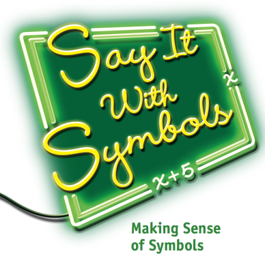Say It With Symbols
Topics
Equivalent expressions and equations. Modeling situations with symbolic statements, volumes of cylinders, cones and spheres, solving linear and quadratic equations. linear, exponential and quadratic functions
Overview of Changes
Changes Added problems on volume of cylinders, cones and spheres
Detailed Description of Changes
Brief Summary of the Algebra Strand at this point
The algebra strand in Connected Mathematics is organized around two major ideas; equivalence and patterns of change (relationships). In addition to the traditional roles of symbols, students in Connected Mathematics learn to use symbolic expressions to represent and reason about relationships and to manipulate symbolic expressions into equivalent forms to access new information about a given context. Access to graphing calculators and computers and the organization of the curriculum around problems provide a natural focus on functions and their use in modeling patterns of quantitative change. Hence, there is more emphasis on multiple representations such as graphic, tabular, and symbolic representations.
The algebra units begin in 6th grade with a focus on relationships and their representations. Equivalence of representations is a natural companion to the study of relationships. Some attention is given to simple linear expressions as specified by CCSSM. Specific relationships or functions become the focus of the next few algebra units, Moving Straight Ahead (linear relationships), Thinking with Mathematical Models (linear functions and inverse variation), Growing, Growing, Growing (exponential functions), and Frogs, Fleas, and Painted Cubes (quadratic functions). Equivalent representations continues to be a theme, but the need for equivalent symbolic expressions becomes more prominent in Frogs, Fleas and Painted Cubes and becomes the central focus in Say It With Symbols. Functions continued to be part of the exploration in this unit as most of the equivalent expressions students generate represent functions. In this unit all of the functions come into play and students have a chance to explore a set of problems in which they have to decide which function can be used to model the situation. Another aspect of equivalence emerges as students use their algebraic understanding to write a sequence of algebraic statements to confirm a conjecture.
Changes
There are two big changes: one is the inclusion of a set of situations in Problem 4.4 in which students have to decide which function provides an appropriate model that represents the situation and hence can be used to solve the problem or make predictions. The second change is the addition of two problems (2.3 and 2.4) that explore the relationships among the volumes of cylinders, cones, and spheres. Students use an experiment to determine the relationship and then write them as algebraic statements. They then write these statements in simpler equivalent forms. In so doing, they arrive at a formula for finding the volume of a cone and sphere based on the volume of a cylinder with the same height and radius. They determine the volume of a cylinder by comparing it to a rectangular prism.
| New Investigation | Changes in CMP2 Investigations |
|---|---|
| Investigation 1 Making Sense of Symbols: Equivalent Expressions | Investigation 1 in CMP2 is essentially the same as Investigation 1 in CMP3 |
| Investigation 2 Combing Expressions | Problems 2.1 and 2.2 are the same as Investigation 2 in CMP2. Problem 2.3 has been moved to Investigation 4. Two new problems on volume of cylinders, cones and spheres have been added to Investigation 2 for CMP3 |
| Investigation 3 Solving Equations | Investigation 3 in CMP 2 is essentially the same as Investigation 3 in CMP3. |
| Investigation 4 Looking Back at Functions | The three problems in Investigation 3 in CMP 2 are essentially the same as Investigation 3 in CMP3. Problem 2.3 from CMP 2 has been added and is now 4.2. Problem 4.1 is the same; 4.2 is now 4.3 and 4.3 is now 4.4. |
| Investigation 5 Reasoning with Symbols | Investigation 5 in CMP 2 is essentially the same as Investigation 5 in CMP3. |
